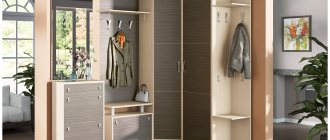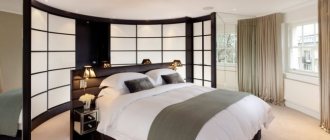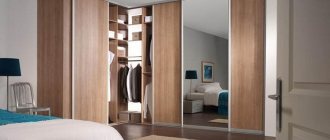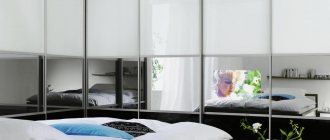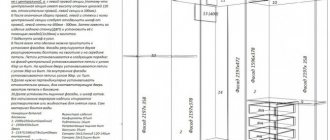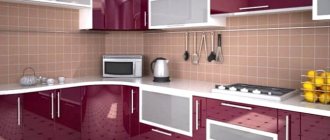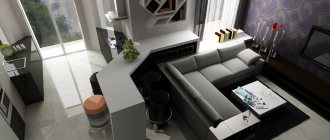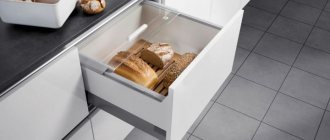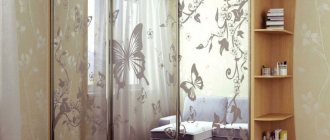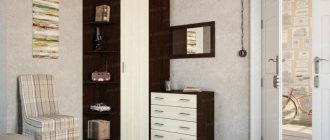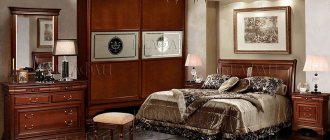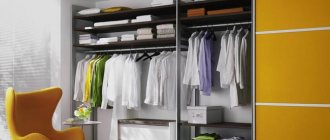Even in a spacious house or apartment you have to think about the rational use of space - every year the number of things increases. What can we say about small-sized apartments? Every centimeter counts here. One way to make optimal use of space is a corner wardrobe. This type of furniture allows you to occupy corners that are rarely used in general - it is difficult to install something there. Next, we’ll talk about what they are and how to plan the “filling” correctly.
Structure, types, sizes
The corner wardrobe can be built-in or cabinet. In built-in ones, room structures are used as walls, floors and ceilings. A façade with sliding doors is attached to them. That is, this design turns out to be stationary - the guides are attached to the walls, floor and ceiling. The advantage of this type of corner cabinets is its cost-effectiveness, the disadvantage is the impossibility of portability. Another important point: the walls, floor and ceiling must be level, otherwise the structure will be skewed, which will negatively affect the operation of the sliding doors.
The cabinet corner wardrobe has its own walls, floor and ceiling
Cabinet corner wardrobes are full-fledged furniture with walls, floor and ceiling. They differ from a regular wardrobe in the presence of sliding doors and in the fact that in height they usually occupy the entire space up to the ceiling. They are delivered from the factory or workshop disassembled and assembled locally, as they have such dimensions that they simply will not fit through the doors.
Types by structure
The shape of corner wardrobes can be of several types:
- L-shaped. The closet occupies two adjacent walls and the corner between them.
If you occupy two adjacent walls under a corner wardrobe, a lot of things will fit
Diagonal with a cross-section in the form of a triangle
Trapezoidal - asymmetrical models
Five-walled - more convenient to use the internal space
To make the difference in structure more clear, it is better to look at all models in a graphical representation (pictured below).
Types of corner wardrobes
If we talk about ease of use, then the best option is L-shaped. Normally, you can assemble the contents in a five-wall and trapezoidal wardrobe. The most inconvenient, of course, is the triangular one. It will have triangular shelves on both sides, which are not very spacious. At the same time, the middle will be empty, since the filling of the cabinet is located along the walls. The same can be said about the five-walled room, with the only difference being that there are no triangular shelves here.
What material
Corner and any other wardrobes are made from the same materials as traditional furniture - wood, MDF and chipboard. Wood is almost never used, since it is too expensive and heavy, and its decorative properties cannot be advantageously presented in this design. Laminated chipboard is much more often used. It is more affordable in price, and also has many color options. It can be an imitation of wood, rattan, etc., or it can be a smoothly painted or textured plain, matte or glossy surface. There are also films with different types of designs - graphic and floral. All of them can be used for laminating chipboard.
Any of the designs can be made with elements of radial technology - with rounded corners. Such sliding wardrobes are made from MDF, the manufacturing technology of which allows the production of rounded shapes. MDF is also laminated and there are no fewer color options.
Corner L-shaped wardrobe with radial elements
As you can see in the photo, near the entrance and in the middle part the corners are not sharp, but rounded. Firstly, it looks beautiful, and secondly, it is safer - there are no sharp edges on which you can seriously hurt yourself.
Dimensions
The easiest way is usually to decide on the height - right up to the ceiling or a couple of centimeters lower. All other parameters depend on the room in which you plan to install a corner wardrobe and the available space. We can probably say about the minimum sizes:
- If the cabinet is diagonal with a triangular cross-section, then the minimum length of the sides at the right angle is 120 cm. The volume will be very small, although they can also make walls with a length of 100 cm or even less.
- If one of the walls is longer (120 cm and 80 cm, for example), it is worth considering the option of a trapezoidal section. On the side that is longer, a partition is placed, the depth of which is about 40-45 cm, and a straight line is drawn from it to the short side.
“Serial” models start from this size, but there are also “small” ones - from 80 cm on at least one side
In a small room, the best choice is an L-shaped design. It is the least massive and leaves more space free. To visually assess this, draw all suitable types of cabinets on the floor plan. Then you can calculate the remaining free space.
A few words about the depth of wardrobes. There are two standard options - 45 cm and 60 cm, the minimum depth is 40 cm. With a width of 60 cm or more, a regular crossbar or pantograph is installed under clothes on hangers in the closet (so that the entire height to the ceiling can be used). Smaller models require a special rod that allows you to place hangers parallel to the door, since the hangers have a standard width of 55 cm and simply do not fit.
Built-in model
After preparing the space for the built-in wardrobe, determine the appropriate dimensions:
- For height, the following rule is obvious: in order to extract maximum functionality from the wall, the furniture must be “under the ceiling”.
- The depth of the wardrobe with a hanger bar, which is planned to be used for storing clothes, is 50–55 cm. For a compartment with a sliding system, the depth will be 60–65 cm. For a shallower option (30–35 cm), it is important to take into account that the walls of the furniture will need to be secured to the wall for stability.
- The width is selected in accordance with the length of the wall or niche prepared for the built-in structure.
Having determined the dimensions, proceed to measurements. It is important to understand how all measurements are taken, because not every niche or wall has the correct geometry. What measurements will be needed:
- The height and width of the back wall in three places. Verticals are measured in the middle and at both edges.
- Measurements are also taken in three places, departing from the back wall a length equal to the depth of the future structure.
Important
Be sure to pay attention to the unevenness of the walls, their blockages, as well as the thickness of the material. The minimum indicator is taken as the basis, otherwise the cabinet simply will not fit into the planned location. But too large gaps are not needed; everything needs to be carefully calculated. The verticality of all surfaces must be checked and leveled, if necessary.
Calculation of parts is very important when making furniture yourself. You should move on to it after preparing the drawings and calculating all the necessary dimensions. It is also necessary to calculate the cabinet to understand the cost of its manufacture. It is possible that the amount saved will be quite insignificant, and it would be better for the owner to order it from professional furniture manufacturers.
Filling corner cabinets
Like any sliding wardrobe, the corner wardrobe has a certain set of shelves, drawers, baskets and sections for hangers. The peculiarity of the corner cabinet is its shape: there are a number of inconvenient places that, nevertheless, must be used. In some models there are more such inconvenient places (diagonal), in others there are fewer (L-shaped). Proper filling of these inconvenient places is the main task when developing the internal filling of a corner cabinet.
It is necessary to plan the filling in stages
How to fill corners
The difficulty is the use of narrow triangles in diagonal and trapezoidal models. Shelves are usually located here. This is the best option, because there are always small things that can be stored on these shelves.
Shelves are made on the sides of the diagonal corner cabinet
No matter how much you look for options for filling such structures, standard layouts almost always have shelves installed there. There are creative options. For example, a compartment for some long and narrow things - such as umbrellas, skis and ski poles. Or - add hooks or jumpers for storing ties, belts and other similar small items. There are simply no other opportunities to use this type of space.
Filling the working volume
After filling these difficult places in the corner wardrobe, you need to sort out the rest of the space. You can plan it at your own discretion. For example, if the style is classic, mainly business clothes, then you will need more compartments for hangers with hangers than shelves and drawers. The most important thing is to use the entire available volume rationally.
There are three types of cabinet filling: baskets or drawers, crossbars for hangers with shelves. The size of the boxes, depending on their purpose, may vary significantly. First of all, it depends on the room in which the closet is located: for the living room, drawers may not be needed at all, but for the bedroom their size should correspond to the volume of stored bed linen, or there may be several of them: for replaceable pillowcases, sheets, duvet covers, the blanket used, pillows, etc.
For corner compartments in the hallway, the drawers may not be used or may be reserved for small wardrobe accessories, for example, household items, gloves, scarves, etc. The most convenient location of the drawers is at hip level. There are shelves above and below. Above are compartments for hangers and hangers. Also, the lower space of corner compartments is often reserved for shoes: shelves located at a distance of 0.3 m from each other. Higher, up to half a meter, shoe shelves can be used to store high boots.
Facade selection
The appearance of the corner wardrobe depends on how the doors are designed. They are the ones who attract attention. They are made from:
- MDF and chipboard. Durable and relatively inexpensive materials. They have a lot of colors and textures: imitation of wood of different species and colors, colored smooth-painted surfaces with shine (glossy) or without (matte), designs and ornaments of different styles and types.
Corner wardrobe with MDF facade
With glass doors, even a massive structure does not look so heavy
Mirrors are almost a classic of the genre
This piece of furniture cannot be called inconspicuous
Combinations often look more interesting
Curved smooth lines look much better than broken or straight lines
With all this diversity, it is necessary to remember the influence of color on the perception of furniture. Since a corner wardrobe usually occupies a fairly large area, it largely determines the “sound” of the entire interior. Therefore, it is necessary to remember several truths. There aren't that many of them. First, mirrors push boundaries, expanding space. Light semi-gloss or glossy furniture and facades with light glass work approximately the same way. Secondly, dark furniture makes a small room even smaller. If you at least take this into account, there will be fewer questions.
Material
The entire manufacturing process of the designed furniture will depend on what is chosen as the main material.
Here, both decorative and technological aspects of the aspect should be taken into account. The financial side of the issue is also important. What to choose:
Tree
Traditional, and now even prestigious material. Its disadvantage is the possibility of warping when humidity changes. Alternatively, it may have a right to exist.
Drywall
It is difficult to classify it as a furniture material, but a cabinet can still be made from plasterboard. It can only be used in combination with a metal frame, so you can build a wardrobe from plasterboard yourself. The doors will be made of a different material. It is more of a building structure than furniture.
These materials suitable for the manufacture of various cabinets include:
- Chipboard laminated or cached with decorative film;
- particle board of various densities and moisture resistance.
Children's furniture is made from grade E-1 boards.
- MDF (fine fraction) made of wood impregnated with a binder. It has found its greatest application in furniture making.
- Fiberboard (fibreboard), the same hardboard.
MDF boards and high-density laminated chipboard are the most suitable materials for furniture construction. The most responsible approach should be taken when calculating the width of the sashes.
Recommendations should also be given here:
- You can't make too many of them. It will just be inconvenient.
- You can’t make them too wide - it will jam if the move is bad. The most practical width is no more than 700 mm.
- The overlap of doors must be done within 50-70 millimeters. If there is more, it will be inconvenient to use the internal shelves. If it is less, cracks will appear and you will need to use the sashes with caution.
- The narrowest shelf should be wider than the door, otherwise it will be inaccessible.
Photo of design ideas and interior layout
Each corner wardrobe is an individual design. This type of furniture is good because it allows you to adapt to the lifestyle and taste of everyone. But sometimes you need an idea for inspiration, and the easiest way to find it is in a photo of finished furniture.
The design of the corner wardrobe can be in any style
A corner wardrobe in the bedroom is a great way to hide everything unnecessary
Light neutral tones make the interior lighter
Mirrored cabinet door instead of a full-length mirror
Another option for filling a five-wall wardrobe
A corner wardrobe in the hallway is often complemented with a hanger and a small shelf for shoes
Radial sliding wardrobes can have either convex or concave edges
Smooth lines resemble waves
Mirrors make the room visually wider
This is no longer quite a corner wardrobe. More like a small dressing room
Combined facades are most often made with mirrors
White gloss and mirror. This solid-sized cabinet does not look bulky at all.
A corner cabinet is one of the most ergonomic pieces of furniture in a modern kitchen. It does not take up useful floor space, does not restrict the already limited possibilities for movement in small standard kitchens, and provides more space for storing all kinds of utensils. These cabinets are made from a variety of materials and are designed in different styles and colors according to the customer's wishes.
Kitchen corner cabinets come in many varieties, and for this reason, before purchasing them, it is very advisable to make special drawings of the placement in the kitchen where the cabinet will be installed.
Regardless of the size of the room, people learned to use corners rationally back in the century before last, because nowadays the shortage of free space is visible everywhere. Each individual case requires an individual solution, but the need to comply with the general laws of planning and selection of such cabinets is obvious.
Kitchen cabinets can be clearly divided into two types.
Mounted
L-shaped cabinets are distinguished by their spaciousness. They are often equipped with double-leaf “tram” doors, which makes the interior space of the cabinet as accessible as possible. Triangular-shaped cabinets are hung where there is no adjacent section due to the fact that it will not be very convenient to use them due to the straight-shaped door, which will block access to the adjacent section. The trapezoidal shape of the cabinet has an advantage in capacity of approximately 20% compared to the L-shaped version. The radial shape of the cabinet differs from the trapezoidal one only in the door - it is semicircular, as the name implies. Such a door is impossible or very difficult to make outside a workshop, so this furniture belongs to a higher price category.
With the exception of very rare cases, massive household appliances are not installed in wall cabinets. Consequently, they are not as durable and spacious as under/floor units. In width (for a small kitchen) it can be 1500-8000 mm depending on its configuration (triangular, trapezoidal, L-shaped). We took 3500 mm as the standard cabinet depth; the distance between the bottom of the wall cabinet and the countertop is not recommended to be more than half a meter (+/- 500 mm), but these are average sizes that are suitable for most users of standard kitchens, although corner structures can be of any size according to customer's request.
Floor
First of all, such a cabinet is chosen taking into account the dimensions of the kitchen (gas or electric) stove. For a small kitchen, a depth of no more than half a meter is recommended. The standard height is calculated as 8500 mm with the assumption of its reduction due to the small height of users. Width dimensions vary between 1500-8000 mm, optimally 6000 mm.
Depth calculation
In a wardrobe there is such a thing as useful space in the depth of the cabinet - that part of the structure that is used for storage.
“Useless” is considered to be the space allocated for the sliding system mechanism. Usually it is 100 mm, so they need to be subtracted from the desired depth.
When choosing a size, take into account the planned functionality. When making calculations, take into account the measurements you made earlier: the distance to important objects. If you want to install a cabinet that is 800mm deep and there is a switch 500mm from the wall, then you will have to either move the cabinet, ditch the switch, or accept a 500mm depth. But keep in mind that only 400 of them will be “useful”.
Standard dimensions
A corner kitchen cabinet must simultaneously correspond to the size of the kitchen, the technical characteristics, and the wishes of the customer. Today, sellers provide kitchen units of standard sizes that correspond to the size of the kitchen, but there are no strict norms and rules that would dictate their size. All dimensional ratios are dictated by the size of the specific kitchen. For example, an L-shaped “Khrushchev” kitchen will require a ratio of 2.6x1.2, and a “Brezhnev” kitchen will require a ratio of 2.8x1.8.
The height of the wall to the ceiling is also of great importance. In “Khrushchev” apartments, a headset height of 2150 mm will be needed, and in “Brezhnevka” apartments or in standard modern apartments it will exceed 2400 mm. If we talk about “Stalin” buildings, the height here often exceeds 3000 mm.
Standards for floor furniture:
- height – 850 mm;
- the thickness of the tabletop is calculated depending on the material and expected load;
- It is not recommended to make the depth of the tabletop less than 460 mm (the right drawer will take 450 mm + 10 mm will go into the gap to the back wall); it should protrude forward above the cabinet door by 5-30 mm.
Standards for wall furniture:
- height – 790-900 mm;
- depth – 300 mm;
- You should not hang the cabinet above a level of 2100 mm, and the distance from the countertop to the wall cabinet should be at least 450 mm;
- the sides adjacent to the walls are 600 mm, not taking into account the 130 mm cut;
- the walls that are adjacent to adjacent segments have a length of 315 mm each;
- the façade is 380 mm wide;
- the shelf must correspond to the weight of the utensils that are planned to be stored on it;
- the standard shelf thickness is 18 mm, but to store heavy items the shelf must be strengthened to 21 mm or more;
- there is no need to make boxes deeper than 400 mm, while taking into account the possible presence of communications (pipes, wires) passing near the wall;
- placing a wall cabinet above the kitchen stove sharply limits the height of the cabinet - there must be a sufficient gap between them;
- The standard of corner cabinets is 600x600 mm with a facade of 420 mm and a depth of 300 mm.
Devices for convenient storage
A great way to use deep corner niches. Or just store a few dozen shoes in a small space. You can easily check your inventory and choose the right model for your morning or evening dress.
Pull-out shelf with compartments for ties and underwear.
Small accessories and underwear can be conveniently placed in shallow compartments to keep everything organized. Removable shelves and drawers allow you to quickly select and organize your warehouse organization. You don't have to rummage through boxes to find a pair of socks.
Trouser drawer.
If you have a large collection of trousers in your wardrobe, a trouser drawer is an ideal solution as it allows you to use as little wardrobe space as possible. And they're easy to stick right into your hands. Some trouser hangers extend automatically when you open the closet door.
Retractable rod
Pants take up minimal space in the closet and allow you to compactly store shirts, dresses, trousers, etc.
Removable shelves for underwear
The corner cabinet allows you to create deep shelves. However, this is not always convenient. Anything left on the back shelves gets lost, forgotten, and wasted. There is a way out. Just move the shelves. In this case, the visibility of what you store will increase many times. You will always know where everything is. It's easy and practical to find what you're looking for, wherever it is.
Laundry baskets
Knitted fabrics don't like to be worn out. Use clear containers and linen baskets to extend the life of your clothes. Order sliding models for comfortable use. In this case, any man will quickly find the right thing deep in the wardrobe and without the help of his wife.
For vacuum cleaners
Vacuum cleaners are also often stored in closets. All these snakes, pipes and nozzles are trying to bring the element of chaos into the perfect order that you ask for. So you need to make room for this hook cleaning helper to hold the piece. Then your bedroom will be in order in every centimeter.
Shoe shelves
Usually shoes are stored at the bottom of the closet or in drawers. However, this is not the only option. Find out more about how to conveniently arrange pairs in store cabinets. You can see them all. Doesn't take up much space. Similar metal racks can be attached to the walls of the cabinet. And if you have a lot of shoes and too little space, you can resort to zippered storage.
How about a simple built-in wardrobe in the corner of the bedroom? It turns out that this topic, like a good TV series, provides food for thought in more than one article. This time we touched only on the types of corner furniture, materials and some tricks that allow you to store things conveniently and practically.
Here is an updated selection of photos that will show what modern corner wardrobes look like in the bedroom.
When planning departments, you need to take your wardrobe into account. How many clothes are of this or that size, how extensive is the collection of shoes and bags.
Height of departments
- For dresses, coats and raincoats allocated 150–180 cm, the remaining space below will be used to store shoes in boxes or for vacuum bags.
- Shirts, blouses, shorts and trousers thrown over the bar will take up about 120 cm.
- Leave 140–150 cm for the trousers to hang on the clips.
- Summer shoes take up about 10-15 cm depending on the heel. Winter is much higher and will require 20 to 30 cm.
- The fashion for tall hats has sunk into oblivion, so 20 cm is enough for them.
- It is convenient to store linen and knitwear in small piles so that they can be easily pulled out and folded. Convenient height of the linen shelves is 30 cm.
- Drawers and shelves for underwear and accessories usually take up from 5 to 15 cm, depending on what exactly will be stored.
Section width
If you're ordering a custom wardrobe, it makes sense to measure your laundry according to the shape in which you usually fold it. Each housewife has her own system. Some people prefer the Japanese way of folding things into rolls, while others traditionally form neat piles in the European style.
- According to your personal preferences and traditions, from 30 to 60 cm are allocated for underwear.
- Suitcases and travel bags take up from 60 to 80 cm.
- The length of the strap for dresses and trousers is no more than 1 m, otherwise you need to take care of its additional support from below or above.
- Boxes and baskets occupy from 30 to 80 cm, depending on their purpose.
- If you like to store things in boxes, choose containers and measure the width of the shelf as a multiple of the box size.
- Removable end rods are placed in 60 cm wide niches to keep clothes loose and wrinkle-free.
Differences in box sizes
An original and practical solution for corner cabinets in kitchen units can be the use of drawers. This is quite unusual, but very ergonomic and convenient to use.
Advantages:
- a corner drawer makes the kitchen unusual and looks unique;
- a retractable drawer makes maximum use of the space in the corner of the room, which is always difficult to access;
- it becomes possible to model the internal volume as you wish - you can always install the required number of partitions in the box, divide it as you wish, in order to know where each item is located.
The disadvantage is the high cost. Boxes will require a larger investment compared to regular doors.
The size of the drawer depends entirely on the area of the kitchen. Offers from hardware manufacturers range from bottom corner cabinet drawers 900mm to 1200mm with a depth of 650mm. It must be said that high-quality retractable fittings can withstand the weight of the contents of the box of more than 40 kilograms.
Several life hacks.
- Typically, these types of small drawers are used to store cutlery, small kitchen utensils, small dishes, spice containers, etc.
- To increase the capacity of the box, its side walls are usually “extended”. It becomes deeper and more spacious.
- To reduce noise when closing, it is recommended to use a built-in shock absorption system. In addition, the absence of impacts on the back wall will increase the life of the furniture.
- For greater comfort, there are systems for electric opening of drawers, which, of course, will further increase the cost of a corner cabinet.
To see where the corner kitchen set should end, see the following video.
The corner wardrobe is in great demand among buyers around the world. This is highly functional furniture that allows designers to create comfortable and beautiful interiors in residential premises for various purposes. Further on what a corner cabinet should be like, its dimensions, features, drawings of which are collected in a selection.
Let's look at the best (second) option
First, you need to decide on the overall dimensions of S.
The width of the facade, or, for clarity, size F (Fig. No. 3) will directly depend on them.
There are reasons for this.
The module must have some height H.
smart door with video screen
So, the larger the size F, the more the geometry of the box facade will approach a square (and it should be a rectangle). And in this case, the work (opening and closing) of such a facade will create large loads on the hinges with which it is attached to the entire structure. Of course, this will not make them work better or longer.
And it will not be convenient to use such a facade, since it will require a lot of free space for its operation.
It would be impossible to put anything in a façade opening of this size.
Here are the criteria that need to be taken into account at the very beginning of designing such boxes.
As a guide, the dimensions of the corner boxes (size S) should be in the range from 500mm to 650mm.
Let the height of our box be 800 millimeters. Let's decide on its overall depth and width (in other words, its overall dimensions).
You can make the calculation in two ways: from general sizes S to size F, and vice versa.
But in practice, the first option is most often used. This is what we will use.
Let's assume that the dimensions of the box (S) will be 550 by 550 millimeters, and the width of the side of the box (L) will be equal to 300 millimeters. Let's calculate the size according to the width of the facade (F).
I would like to make a reservation right away that in most such cases, you need to know the Pythagorean theorem, which is studied either in the 5th or 6th grade of high school.
It is very simple, you can simply memorize (write it down), and there will be no problems with the calculation of such boxes.
And this theorem sounds simple: The square of the hypotenuse is equal to the sum of the squares of the legs.
Or, if we translate this theorem into our example, then our right triangle is the triangle FPP. Moreover, it is not only rectangular, but also isosceles.
For those who do not quite understand what an isosceles triangle is, I will say it more simply: this triangle has sides P equal to each other (for the reason that the sides of the box S are equal, and the width (depth) of the sides L is also the same)
Simplifying the expression, we get:
F=√‾2P² - this formula can be simply written down and safely applied in all cases that meet our conditions (and there are two of them: the dimensions P of the box are equal, and the width of the sides L is also the same). By the way, these conditions correspond to almost 99 percent of actually designed corner boxes.
I think you understand that even without knowledge of mathematics, having just one calculator, you can make calculations for corner boxes.
Well, we’ll start doing the calculations themselves in the next article.
Source
Features of corner structures
Sliding wardrobes can solve the problem of storing a person’s wardrobe in the bedroom, kitchen utensils in the kitchen, outerwear and shoes in the hallway. Such models are distinguished by good spaciousness and practicality. In addition, for rooms with non-standard geometry, corner structures are an excellent option. They allow you to smooth out irregular shapes, giving the room a more laconic look.
A special feature of such furniture for a bedroom or children's room is the nature of the placement of shelves and storage systems inside. It is also important to pay attention to this when choosing a corner wardrobe. There are models in which the shelves are placed one above the other. That is, the shelf itself is not square, but triangular or trapezoidal in shape. The advantage of such structures, as shown in the photo, is their large capacity, but there are also disadvantages. The disadvantages of triangular shelves include inaccessibility and low comfort for the user, since in the case of a deep cabinet it can be difficult to get to things in the very corner of the shelf. And the drawers in such cabinets can be made not to cover the entire area of the corner, but to a square or rectangle that fits into it. You can also choose a product, behind the doors of which the shelves are located on two walls in an L-shape. This arrangement of storage systems allows you to conveniently arrange the wardrobe of several people, place special devices, for example, a trouser rack, and zone the interior space of the closet.
Kitchen corner with storage drawers: fashionable furniture
There are two fundamentally different furniture designs.
They are called “kitchen corner with drawers”:
- Soviet version, drawers are located under the corner sofa;
- A modern option, the drawers are mounted on a suspended structure like a shelf.
What nuances to consider when assembling a corner sofa with drawers:
- You can upholster wood or chipboard with fabric if you purchase a furniture stapler;
- For even upholstery, the corners are bent at 45 degrees, the upholstery must be ironed before tensioning the fabric;
- To fix the pillows, you need to make a border of 5-10 cm around the perimeter of the back and side walls of the sofa;
- Pillows and upholstery can be bought at a fabric store; if the pillows do not match the color, sew pillowcases from the upholstery material;
- Drawers can be retractable (complex option) or hinged (simple option).
Hinged drawer - purchase regular hinges or a closer (a mechanism that smoothly lowers or moves the door panel to the side). It’s not difficult to make a corner sofa with drawers; this design is even simpler than cabinets.
Standard sizes
Experts insist that the first thing that is important to think about when choosing a corner cabinet is its size. After all, corner cabinets can have standard parameters, or they can be made to order according to a prepared project with specific measurements. The first option is characterized by lower cost, versatility, and practicality. There is no need to wait a long time for the manufacturer to create a custom-sized cabinet for you. It is enough to choose a ready-made model in the store with the necessary parameters, the design of which you like.
Triangular
If the room has the correct shape or decent dimensions, it is worth choosing a triangular corner wardrobe for it. The optimal length of the sides for such a triangular cabinet will be 1.2 m. If you make the sides of the structure too small (for example, sometimes you can find models with sides of 1 m), then the product will be of little functionality and not very spacious. If they are too large (for example, 1.5 m), then the furniture will turn out to be excessively bulky. The minimum depth of such a cabinet is 0.4 m, and the maximum is 0.6 m. Corner triangular cabinets with a depth of 0.45 m are often found. With a model depth of 0.6 m, experts advise using a regular crossbar for placing dresses on hangers. If the depth of the product is 0.4 m, you will have to use a special rod that allows you to place the hangers parallel to the door. A standard 0.55m wide hanger simply won't fit in a shallow closet.
For a small-sized triangular corner cabinet, it is better to prefer an L-shaped arrangement of shelves, since such filling of furniture will not be massive and will leave enough space for comfortable use of the room. To evaluate this visually, experts recommend drawing all types of sliding wardrobes on the plan of a specific room. Such drawings allow you to accurately calculate the area of the remaining free space.
Diagonal
If you consider the cross-section of such a compartment locker, it will be triangular, but the sides of such products will not be the same. Diagonal models are used for rooms with several doors or window openings located on adjacent walls. The parameters of corner wardrobes of diagonal type for the average living space of a city apartment are described in the table.
| Options | Minimum value, m | Maximum value, m |
| Height | 1,7 | 2,5 |
| Depth | 0,5 | 0,7 |
| Width on each side | 0,7 | 2,4 |
The optimal height of a diagonal model for a city apartment is considered to be 2.2-2.5 m, since the ceilings here are often 0.3-0.4 m high. That is, 5-6 shelves will fit inside.
When choosing the number of doors for a diagonal cabinet, experts recommend starting from its width. If a wide design is selected (for example, 2.2 m), then it should have three compartment doors (approximately 0.7 m each). This will give the model the maximum level of comfort.
Trapezoidal
The trapezoidal shape of corner cabinets is great for children's rooms, living rooms, kitchens, and offices. Such designs, as demonstrated in the following photo, are applicable even in a tiny entrance group, where every meter of free space counts. But due to their impressive depth, they are more recommended for installation in spacious rooms.
The level of capacity of such a model will be slightly higher than that of a similar-sized diagonal cabinet. This becomes clear if you consider a photo with a graphic representation of the compared structures.
Standard dimensions of a trapezoidal cabinet: the length of one wall is 1.2 m, the second - 0.8 m. A partition with a depth of 0.45 m is installed on the longer side, and a straight line is drawn from it to the short side. If you are selecting a cabinet for installing a sink in the kitchen, then the optimal height of the countertop is 0.85 m, the length of the side walls is 0.9x0.9 or 1.0x1.0 m, and the depth is 1-1.2 m.
The design of trapezoidal hanging cabinets for the kitchen is laconic and unusual at the same time. The dimensions of such structures are standard: 0.6x0.6 m.
Radial
Radius corner cabinets have a higher level of capacity due to the fact that the doors of such furniture are not flat, but somewhat convex outward. The door leaf moves to the sides not along straight guides, but along a semicircle, which allows you to give the piece of furniture a unique design. You can appreciate the beauty of radius structures in the following photo.
It is not difficult to fit such a design into a living space, because they, like other types of corner cabinets, are made in standard sizes. The height of a radius wardrobe for clothes can vary from 1.8 to 2.4 m, width - from 1.2 to 2.1 m, and depth - from 85 cm to 1 m. If we talk about a wardrobe for a kitchen , then manufacturers often offer models with parameters of 0.9 by 0.9 m, a height of 0.85 m and a depth of 1 m.
But it is better not to choose it for narrow spaces. Radius models require slightly more space than products with flat doors, so it is optimal to install a radius wardrobe in a spacious living room. In addition, the more complex design of the sliding system affects its cost. Radius models are sold at higher prices, so they are used mainly to create original, respectable interiors. In a bedroom with a budget renovation, the design of which is made as simple as possible, it is irrational to buy such furniture.
How to choose the right cabinet depth: rely on 5 parameters
When choosing a closet, you need to find a compromise between its capacity and the size of the room. It is not simple. It may turn out that roomy furniture will take up too much space, and the one that fits well will not fit everything you need. To prevent this from happening, you need to choose the right cabinet depth. We will describe the possible options and tell you how to make a choice.
What depth of cabinet should you choose?
Standard wardrobe depth
The depth standard of a storage system depends on the design. So, for models with hinged doors it is 60 cm. For built-in and free-standing wardrobes - 70 cm. The differences are related to the size of the doors. Hinged doors are thin, their thickness is only 16-32 mm. It depends on the material: chipboard, MDF or chipboard. Sliding structures always take up more space: they account for 50-100 mm.
The remaining distance is enough to comfortably place clothes. The length of standard hangers is 50 cm. They will fit freely on a horizontal bar, and the clothes placed on them will not prevent the doors from closing freely. For children's models the standards are different. Swing models - 45 cm, coupe - 55 cm.
Custom sizes
Corner compartment models of non-standard size or shape are especially relevant for narrow rooms where there is very little space, or irregularly shaped rooms with a free corner. But it will not be possible to choose a corner cabinet of a non-standard size in a furniture store, because mass-produced furniture is aimed at rooms of standard dimensions.
What to do if you need an original piece of furniture, if you want to give your home a unique design, abandoning hackneyed shapes, internal fillings and standard furniture sizes? In such a situation, you can turn to manufacturers who create custom-made furniture products. With their help, a product design, drawings with dimensions, and a diagram of its assembly are created. Let us describe possible deviations from the standard sizes of corner cabinets:
- The minimum permissible depth of a corner wardrobe is 0.35 m. From this value you need to subtract 0.1 m for the installation of a sliding system, then the shelf itself will be 0.25 m deep. This is not very convenient, although it is not yet critical. Even shallower shelves will be non-functional. And the maximum depth should not exceed 0.9 m, since it will be extremely difficult to reach the contents of the cabinet;
- the minimum width is 0.1 m. The doors of such products will have a width of 0.45 m. Even narrower doors will be inconvenient for the user and unstable.
- There are no height restrictions. You can make models for the ceiling, complementing them with a convenient ladder for accessing things on the upper shelves. But remember, a cabinet 4 meters high will look very bulky, and a small child will not be able to move its doors.
Necessary measurements and calculation rules
Help
Correct measurements are 50% of the success of further assembly and installation of the cabinet. Unfortunately, floors and walls are rarely even. And the furniture is created with right angles. When taking measurements of the space for installing the cabinet, they take into account all the unevenness of the walls and create technological gaps.
To determine the size of future furniture, you will need to measure the width and height in several zones at once (width in relation to the ceiling and floor at the required depth, top, bottom, middle along the wall, cabinet height at several points).
To prevent finished furniture from collapsing due to its own gravity, the dimensions are pre-calculated:
- the cabinet itself;
- doors;
- the length of the shelves (which determines whether they will sag during use);
- dimensions of boxes, their number;
- useful depth of shelves (if a sliding door system is selected, an additional 10 cm of depth will be needed);
- other.
Calculation of corner modules: main points
Today, as I promised, we will look at corner modules.
This is a fairly simple topic, but for some reason it causes difficulties for many novice furniture makers.
And as an example, I propose to analyze the design of the most common upper trapezoidal box.
Its configuration may be different, depending on the purpose.
It can be a working one (have shelves inside, or a drying rack for dishes), or it can also be a “trick,” for example, to hide a gas boiler or water heater.
So, let's consider its version when there are shelves inside.
The box itself consists of two horizons, two sides, two shelves and a body strip (we are not taking the facade into account for now, since this will be a separate topic). Yes, it will also have two back walls made of fiberboard (for simplicity, we will not take into account the dimensions of the fiberboard (its thickness) in the calculations).
It will be symmetrical, that is, its dimensions in width and depth S will be the same, and accordingly the width of the sides L will be the same (see Fig. 3).
The most important calculations of such boxes, as a rule, are made “in plan”, i.e. when we look at it from above.
So, the module we are considering can be designed in two versions:
In the first option, you will need to count less, but it will have some disadvantages.
These disadvantages will be that during installation (hanging the box on the wall in a corner), problems may arise. And all this is due to the right angle, which is marked in Fig. No. 1.
In the second option (Fig. No. 2), you need to count a little more, but the calculated box will have an advantage in installation.
If the corner in which such a box will be installed has irregularities, bulges and other defects, they will all remain in the free space formed due to the angular cut of the horizons and shelves of the box.
Algorithm for making a cabinet
After registering an application for the manufacture of a cabinet, the request goes into development. The measurer will agree on the product parameters with you and an experienced technologist, taking into account all the features of your premises. At the cabinet design stage, detailed technical specifications are developed and technological maps are prepared. All that remains is to produce:
- Production processes on our equipment;
- Assembly of individual parts into a single structure.
An agreement is concluded with each client. An individual estimate is calculated.
Lesson 19 — How to calculate the dimensions of facades in cabinet furniture
Calculation of facades is a fairly important procedure, because they are the face of the finished product and in some cases (for example, MDF facades) it will not be possible to change anything if there is an error.
In this article I will try to explain how calculations are made for all the main types of furniture facades (with the exception of sliding doors and radius doors). We will disassemble it on the basis of a box with external dimensions of 600 x 300 mm.
So, let's start with swing facades. In order for the doors to open, it is necessary that they do not rub against each other and against the body; technological gaps are provided for this.
They are 2-4 mm (more - they look ugly, less - they rub).
Personally, I prefer to make gaps of 2 mm.
Separately, I note that the dimensions must be calculated for each module separately, that is, if you are assembling a kitchen in which there are 3 floor drawers and 3 wall drawers, then the dimensions must be calculated for each drawer separately, that is, 6 times - this way you will insure yourself against a number of possible mistakes.
The width of the facade is calculated using the formula:
w = (W/n)-3 mm
where w is the width of the facade, W is the width of the box, n is the number of facades (by width)
Some furniture makers subtract 4 mm, but in my opinion the gaps are too large.
Height of facades. When calculating height, there are no clearly defined formulas - you should be guided by common sense and some simple subtleties.
For example, let's calculate the dimensions of the facades for several kitchen modules.
in red , the gaps in blue in orange .
So, the dimensions of the box are 730×450 mm
We calculate the width using the formula (450/1)-3 and get 447 mm. (there are 1.5 mm gaps on the sides, which will allow you not to cling to adjacent cabinets, which will have the same allowances).
In terms of height, we decide to make 3 facades, of which 2 are large, 300 mm each. We take into account that the optimal distance between adjacent drawers is 2-3 mm , and between the tabletop and the upper facade 5 mm (so that the facade does not cling to the drip tray, which is found on kitchen countertops). As a result, subtracting these values from the height of the box, we obtain the height of the small facade 121 mm
730mm - 300mm - 2mm - 300mm - 2mm - 5mm=121 mm
Let's move on to another example: calculation of facades for a hanging cabinet. Its peculiarity is the presence of two hinged facades, as well as an overhang of the upper horizon, which seems to cover the doors, giving the entire cabinet a finished look.
Based on the overall dimensions of the cabinet: 636 x 600 mm, we calculate the width of the facades. (600/2)-3 = 297.
Knowing that the thickness of the upper horizon is 16 mm, and making a 3 mm gap between it and the facade, we get the height of the facade (636-16-3) = 617
Now let's move on to the individual subtleties of the calculation.
1. When calculating the dimensions of facades made of laminated chipboard edged with 2 mm PVC edges, do not forget to subtract another 4 mm from the dimensions, both in height and width (edge thickness on both sides)
2. When calculating the dimensions of hinged facades
for corner cabinets, it is necessary to take into account that there are two types of corner hinges (+45, +30 g).
Visually they do not differ from each other; the difference is noticeable only on the assembled body with a hung facade. Therefore, the installation diagram for the corner hinges that you purchase should be checked with the seller. Let us analyze the calculation for each using the example of a corner cabinet with a distance between the walls (in the façade opening) of 300 mm.
So, option 1, the facade turns out to be inset; its size should be 1 mm less than the width of the niche, that is, equal to 299 mm.
Option 2, on the contrary, provides for the overhead nature of the facade. In this case, the facade is 5 mm wider than the niche (305 mm)
Let us separately dwell on such a topic as the calculation of sliding doors in various variations
